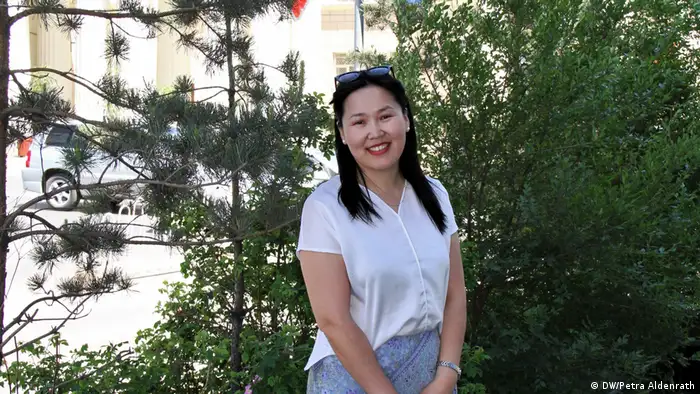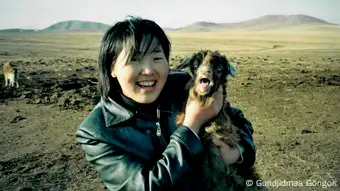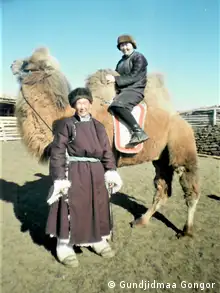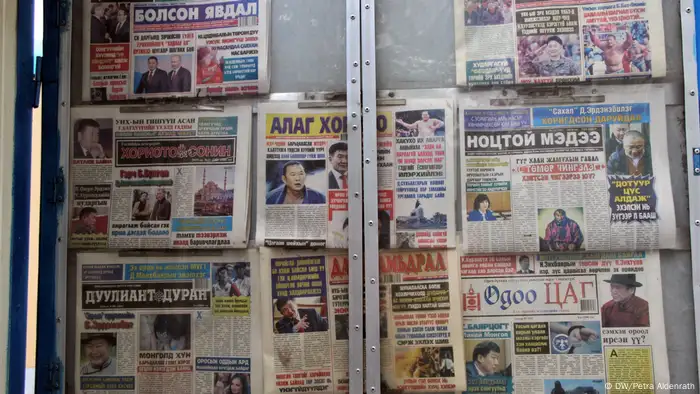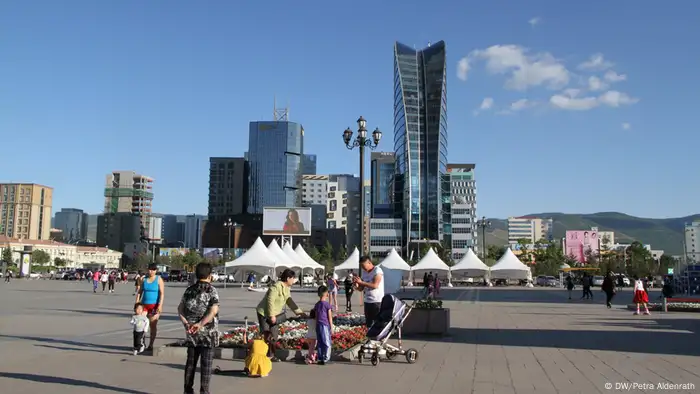our impact
Bridging the gap between the media and the people
The Mongolian Media Council helps ensure that the population can access balanced and reliable information. This is no easy task in a country where the media is often shaped by third-party interests.
First she opens the window and pulls back the curtains. Gunjidmaa Gongor loves fresh air and natural light. She then opens her briefcase, takes out her notebook, switches the mobile phone to silent, and puts paper and pencil on the table. Gunjidmaa Gongor, called Gunjee for short, is the executive director of the Mongolian Media Council. She shares a one-room office with three other staff members, so for meetings she likes to move into an adjoining room at a tea house five minutes away.
1.5 million people live in the Mongolian capital Ulaanbaatar but the actual city center is comparatively small. On the way to the tea house, Gunjee walks through streets lined with stalls selling everything from plastic toys, pots and nuts, to grilled mutton. She then crosses Sukbataar Square, passes the parliament building and turns one more corner. The waitress greets her and puts black tea and instant coffee on the table.
Gunjee takes a sip of tea and starts to talk. In 2015, the Media Council of Mongolia (MCM) was founded. She was there from the beginning and has been the executive director of the media council since 2018. The council’s main task is to receive complaints against media reports that are accused of being false, unethical, or discriminatory. Through her work Gunjee is setting journalistic standards in Mongolia. This is not an easy task in a country where journalism is dominated by the interests of third parties, where politicians continue to exert pressure on the media and many journalists let themselves be bought—either to keep quiet or to target media campaigns against political opponents. As a result, journalism in Mongolia continues to lack independence, objectivity, and ethical responsibility.
"Before we existed, the media worked in their own bubble. Journalists chased rumors and conspiracy theories and did not check facts. The media published everything they wanted to publish," said Gunjee. "Since the Media Council was established, they now know that what they publish is being watched and that unethical reporting can be noticed by the public and reported to us."
A well-versed media council
With a quick look at her mobile phone, Gunjee sees that it’s four in the afternoon. With only two meetings left, Gunjee is looking forward to the end of the day and to going home to see her three "boys": her husband, a journalist, and her two sons. The older one is twelve and the small one is two years old.
"In the past few years I have had two babies: The Media Council and my youngest," she said with a laugh and tucks a stubborn strand of hair behind her ear. Her pageboy hairstyle is in place again.
Gunjee is a real child of the Mongolian steppe. Born in a yurt, the traditional round tent of the Mongols, she grew up in the nomadic regions of the country. Her parents own cows, lambs, goats, sheep, camels, and horses so herding and milking the cattle was part of her childhood. By the age of three, Gunjee was already well versed in the saddle. When the winter temperatures dropped below minus 30 degrees Celsius and the school bus was not running, Gunjee would grab a camel and ride it to school.
"It is warmer to sit on a camel than on a horse. They are slower, but they have a cozy, thick fur and radiate warmth," she said.
After her high school final exams, however, she wanted to get off of the steppe for a while. So she moved to Ulaanbaatar in 1997 and studied sociology and administrative science, a combination that enabled her to find employment at the Press Institute of Mongolia (PIM) after her studies. After a few years, she rose to head of the research department and finally managing director. Her work at the PIM was the ideal foundation for her current position at the Mongolian Media Council.
"All of that was so valuable to me. I learned a lot there about press freedom and independent journalism and how important it is to support both," said Gunjee.
Resistance to the media council
It’s time to go. She places her laptop back in the briefcase and smooths her skirt. She has to return to the office before her next appointment. Establishing the Mongolian Media Council was not an easy task. Since the collapse of communism at the end of the 1990s, the Mongolian media market developed very quickly. With almost three million inhabitants in an area more than four times the size of Germany, Mongolia has the lowest population density in the world. Nevertheless, there is an abundance of media outlets. In 2016, there were 485—including more than 130 television stations and around 100 newspapers and magazines. Previous attempts to set up an organization to monitor the Mongolian media market failed.
"Even journalists were initially firmly against a media council," reported Gunjee. "They said: 'We can regulate ourselves. We do not need a watchdog.'"
With the support of the Friedrich-Ebert-Stiftung and the DW Akademie, a group of committed media representatives, including Gunjee, pushed for the creation of the media council until it was finally established on January 28, 2015.
"It was an historic event for the Mongolian media landscape," said Batbaatar Sodnomdarjaa. Back then he worked for the Mongolian daily newspaper Zasgiin Gazriin Medee and today he heads the communications department in the Mongolian parliament. Since its founding, 45 people have worked with the media council. It consists of a 15-member board and two ethics committees, one for television and radio and the other for print and online media. Gunjee and her three staff members are the only paid employees of the Mongolian Media Council.
A lot of work has been invested in preparing the young organization for the future. From the outset, staff were advised not only on financial, organizational, and personnel matters, but above all on procedural issues such as the drafting of a code of ethics and its application, the implementation of complaints procedures and public relations work.
"Not only did we have to learn everything anew, but the population had to as well. They should know who we are and what we do," said Gunjee. "Before we existed, this form of self-regulation, where citizens can report violations in the reporting, did not exist at all."
It’s different story today. The media council has evolved into a bridge between the media and the population. Since 2015, it has received over 200 complaints and the number is rising. Most of these complaints are about the misrepresentation of facts or incorrect quotes. Here too the main problem lies in the poor professionalism of many journalists, who simply copy reports without checking them or researching whether they are true or false. But discriminatory or insulting statements have also been reported. The media council receives the complaints, then writes to the media houses, asking for a written response and if this does not happen, for an interview.
"In the beginning, the media bosses called us and asked: 'Who are you? There is freedom of the press. We write what we want,'" said Gunjee. The role of the media council is to make misconduct public and condemn it, but it does not use coercive measures or impose penalties. Therefore, good arguments are the best input to help Gunjee decide how to act.
"We explain and explain. We say it’s about democracy, about quality journalism," she added.
These are new demands in a country surrounded by Russia and China, two authoritarian states. Mongolia has taken on a special role in central Asia since the revolution of 1989 and the collapse of communism, as it has chosen to embark on a democratic path.
Heading in the right direction
The light is red. Gunjee waits and then walks with quick steps towards the office. The MMC no longer receives calls from angry media moguls. But many media outlets still ignore its requests for statements and shirk requests for a statement. Therefore, informing the public is still at the top of the priority list.
"Many people in Mongolia think 'media is media,'" said Gunjee. "They don’t know that they are owned by different people with different interests and they can’t always distinguish between rumors and news."
This is especially true in rural areas where such basic knowledge is not available, added Gunjee. Nevertheless, she is satisfied with the work of the Media Council, including the recognition that the organization has received regarding its press codex, which lays down ethical journalistic principles.
"This press codex is not only a written commitment, but it has improved the professional ethics of news editors and journalists," said Narantuya Dangsaasuren, vice director of the Mongolian news portal news.mn.
Gunjee’s office is located in a high-rise building, just opposite the Blue Sky Tower, a dark-glazed, semi-circular building that is considered the modern landmark of the capital. Gunjee takes the elevator to the eleventh floor. At her desk, she quickly boots up her computer and reads up on a current topic: online media outlets without contact information.
"This is a big problem," she said. "Today, anyone can open a site and post news. But many don't register at all. We can’t contact the owners of anonymous websites if they violate ethics."
In 2015, Mongolia climbed 34 places in the Reporters Without Borders press freedom ranking—from 88th to 54th—and Gunjee is sure that the reason for the better ranking was the establishment of the media council. But she is still far from being able to sit back and relax. By 2018, Mongolia already slipped back to 71st place, and in 2019 it landed in 70th place.
"I assume that the main reason for the poor classification is the frequent fines imposed on journalists by the police," she reported. In 2018, 46 journalists were fined around 20 million Mongolian tugrik (€6,500). "These procedures intimidate media professionals and lead to self-censorship."
Gunjee looks at her watch again. She has to go. Traffic in Ulaanbaatar gets much worse in the late afternoon. The next time Gunjee visits her parents, she will help them feed their cattle, and of course take in the peace and quiet.
"Even though I live in the big city, my heart still beats for the steppe," she said. Back in the capital, her inbox overflows and new work is waiting. "We're a small team with a big mission, but we're moving step by step in the right direction."
Author: Petra Aldenrath loves to write portraits and long-form articles. She is an experienced journalist who has worked for newspapers, magazines and radio and has been published in several books. For five years she was the ARD correspondent for Mongolia and China. She has also worked as a freelance reporter from Australia, Indonesia, Vietnam, Canada and Israel. She has been working at the DW Akademie since 2018. She is particularly interested in telling the stories behind the organization's diverse media development projects.
Profile: Mongolia
Who?
- Media Council of Mongolia (MCM)
How does the project work?
- The Media Council of Mongolia (MCM) was founded in 2015 by media representatives. Its independent panel of experts receives complaints about media reports that may violate the code of ethics that the MCM itself has developed.
- In the case of ethical violations, the MCM demands corrections--including apologies if necessary—from the concerned media outlet and publicly explains its decision. However, it cannot take legal action.
What are the difficulties?
- Mongolia has an oversupply of media. In 2016, there were 485 different media offerings, including 131 television stations, for a population of just around three million.
- In Mongolia's media landscape, politics, business, and the media are closely intertwined. Politicians and oligarchs pay media workers or buy entire stations (or publishing houses) to pursue their own agenda.
- Since the media council is not allowed to impose sanctions, it is dependent on the acceptance and cooperation of the Mongolian media outlets. In fact, some media houses continue to ignore MCM complaints against their reporting.
- Critical journalists are often subjected to misdemeanour charges because of their reporting, which can ruin them financially. The result in many cases is self-censorship.
What has the project achieved?
- The Mongolian Media Council has so far received and decided on more than 200 complaints against media reports and that number is increasing. It has thus become a national authority regarding questions of media ethics.
- 45 Mongolian journalists, publishers, and media experts work voluntarily for the MCM and have thus been able to prevent state control of journalism in Mongolia.
What are the highlights?
- When the Media Council of Mongolia was established in 2015, Mongolia moved up from 88th to 54th place on Reporters Without Borders' press freedom ranking.
- The Media Council of Mongolia's press code and the principles that underpin it are now accepted guidelines for the professional ethics of news editors and journalists in Mongolia.
WWW links
- Date 11.03.2020
- Author Petra Aldenrath
- Feedback: Send us your feedback.
- Print Print this page
- Permalink https://p.dw.com/p/3YH6x
- Date 11.03.2020
- Author Petra Aldenrath
- Send us your feedback.
- Print Print this page
- Permalink https://p.dw.com/p/3YH6x

